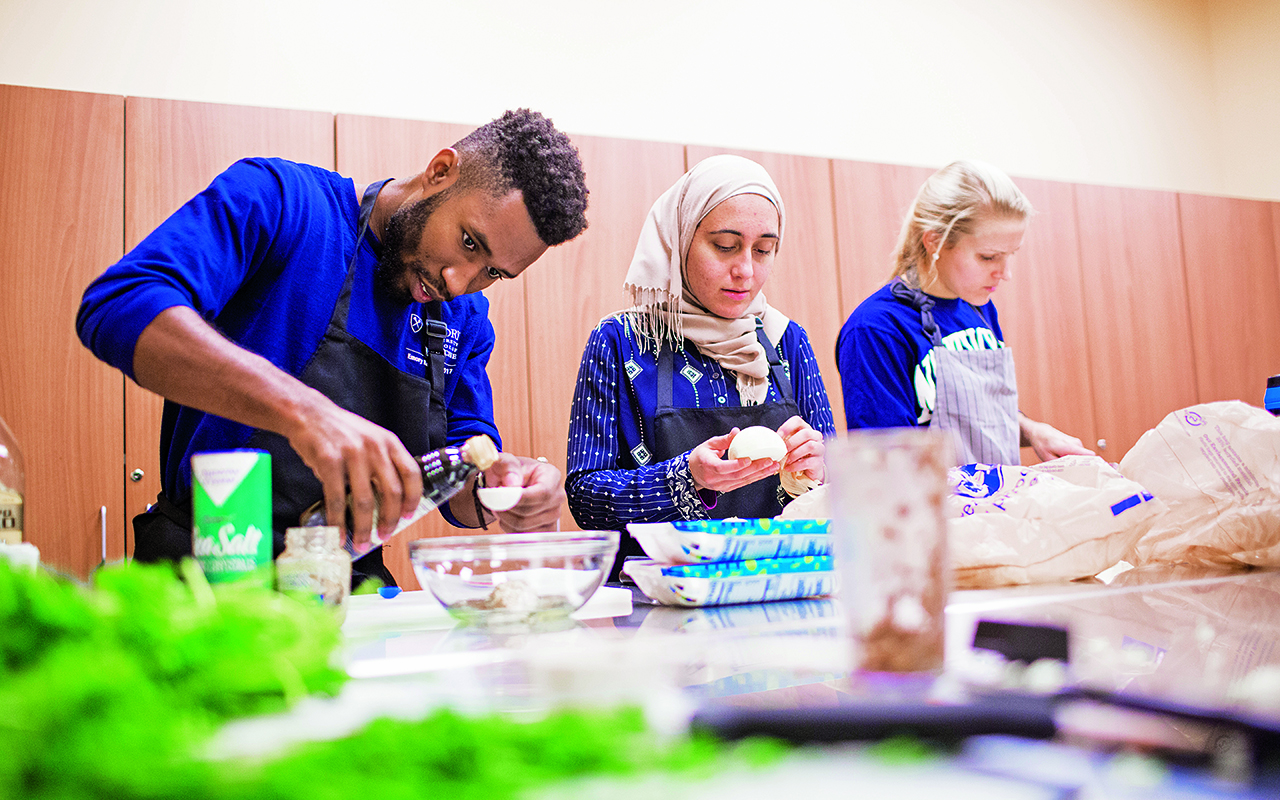Prescription Nutrition

When you think of medical school, you probably imagine classrooms, cadavers, and clinics, not spices, sauces, and stovetops. But a new class integrating food science, cooking skills, and medical needs is challenging students to broaden the focus of healing to include nutrition.
The Emory Department of Family and Preventive Medicine, with Emory University Student Health Services and Emory Campus Life, introduced the interdisciplinary elective course—From Clinic to Kitchen: An Introductionto Culinary Medicine—to second-year medical students.
It teaches nutrition counseling and the skills to purchase, prep, and cook healthy meals. During the pilot, 10 students met weekly at Emory’s Few Hall teaching kitchen.
They were assigned a patient whose medical conditions could be improved by dietary changes. Based on the patient’s disease or condition, eating habits, and socioeconomic status, students researched their nutritional needs, proposed healthy meal options with specific recipes, and provided cost breakdowns. Recipes were compared and critiqued, then the group prepared the meals together.
Leading the initiative are family medicine physician Emily Herndon, preventive medicine physician Javier Valle, student health dietician Carol Kelly, senior director for campus dining Dave Furhman, and Associate Professor of Human Health Jill Welkley.
Feedback was positive, Herndon says, with preliminary data showing it “improved students’ confidence in counseling future patients about appropriate diet changes.” “Food and medicine have been intertwined for centuries,” says Kelly. “Hippocrates, the Greek physician who is considered the father of modern medicine, said it best: “Let food be thy medicine and let medicine be thy food.”
Medical student Annalise Littman recounted her firsthand experiences with patients while zesting lemons for a maple-glazed sweet potato recipe. “Medical school teaches you very little about nutrition, even though questions about nutrition come up constantly when I’m in the clinic,” Littman said, adding that the course changed her food habits at home too— instead of using the same old vegetables to make her dinner, she’s becoming more adventurous.
This week, the class is cooking a full meal for a case study patient with irritable bowel syndrome (IBS).
Most doctors recommend following the low-FODMAP (fermentable oligo-, di-, mono-saccharides and polyols) diet, which cuts out short-chain carbohydrates found in many common foods that are resistant to digestion.
The diet is so restrictive it can feel impossible for patients to follow. Students in the class submitted a low-FODMAP recipe for homework and critique each recipe in class.
From across the room, Chef Furhman shouts a verbal pop quiz: “Can we use cornstarch in the low-FODMAP diet?”
A few students nod. “Good! Now, does anyoneknow what an orange supreme is?” he asks.
This time, there’s silence in the room. He gathers the students around to demonstrate his technique for cutting a thin, sweet slice of fruit.
In addition to cooking for disease management, the students also learn to cook for patients from different cultures.
“One of the patients the students cooked for was a Chinese woman with diabetes who eats rice with every meal,” says Kelly. “It would be unreasonable to ask her to cut out rice from her diet. Instead, she can flip the ratio of rice to vegetables on her plate or substitute with cauliflower rice. This course is all about practical lifestyle changes.”
At the end of the semester, the medical students form teams and compete in a cook-off. Just like a TV cooking competition, the students have a limited amount of time to cook, plate, and serve a meal for a fictional patient.
Students defend their food choices with scientific research and recommend other lifestyle changes to the patient.
For example: the patient with IBS? She wanted a meal that would meet her dietary restrictions but still be appealing to her new “foodie” boyfriend.
One creative suggestion: a turkey burger (red meat would be harder for an IBS patient to digest) and a sweet carrot salad.
“You learn by doing,” Herndon says. “This class allows medical students to experiment in the kitchen and apply what they have learned.”
Email the Editor




